TEDRART TRAVEL
Home ➞ Tedrart Travel ➞ Grand Morrocan Journey
- Casablanca, Rabat, Tangier, Chefchaouen, Fes, Erfoud, Merzouga, Ouarzazate, Marrakech, Essaouira
- - Horseback ride on the beaches of Essaouira
- - Glamping in the desert with camel rides among the dunes
- - Amazing markets and souks
- - The gorgeous High Atlas mountain range
- - Infamous Casablanca
- - Stays in boutique Riads
- - Cooking class in Marrakech or Skoura
- - An Arabic Calligraphy lesson and so much more.
- - Explore the Moorish sites and learn about the wonders and traditions of Morocco.
- Our stuff is considered to be one of the best, with their knowledge and support, they can guide you to make your own dream come true. - The deep little secret, information, tricks and undiscovered places only our guides can leads to.
- Program : Please check the itinerary here:
- This is a private tour that you can book with your family and friends. The dates can be adjusted according to your travel details.
- This tour can also be customized according to your preferences. Whether you're interested in exploring the historical sites, experiencing the local culture, or finding the best spots for culinary delights, the itinerary can be tailored to suit your interests. Enjoy the flexibility of a personalized journey that aligns with what you want to see and do, ensuring that your trip is as unique as you are.
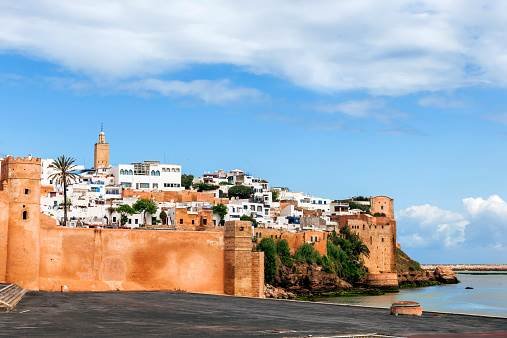
The Adventure Begins
Tour amazing Casablanca, the economic capital of the kingdom. The visit will start with the United Nations Place, Mohammed V, the Marché Central, the Palais Royal qui l’ surrounding, the Quartier des Habbous, the Mehkama (court), the Cathédrale Notre Dame de Lourdes, the residential area of Anfa, external visit of the famous mosquée Hassan II and the beautiful corniche d’Ain Diab lined with restaurants and swimming pools. Morocco’s coastal capital since 1912, Rabat has just over a million people. Modern and even reserved by Moroccan standards, the city also has many fascinating historic sites, including the picturesque Kasbah of the Udayas, built in the mid-12th century. The unique Hassan Tower, begun at the end of the 12th century, was meant to have the world’s largest minaret but was never completed. Just opposite the tower lies the 20th-century Mausoleum of Mohammed V, another of the city’s main attractions. Visit the ancient medina and the ramparts of Mechouar surrounding the Royal Palace.

Tangier- Assila,
Explore the Moroccan port city of Tangier and its surrounding countryside on this full-day sightseeing tour. See many of the landmark locations in downtown Tangier on a panoramic drive through the city. Visit the Caves of Hercules, one of the most popular local attractions. Also, travel to the sandy bay of Cape Spartel and much more. Learn more about the history, culture and architecture of Tangier from an English-speaking guide.
-Take a private sightseeing tour in and around Tangier
-See the downtown area and surrounding countryside
-Visit many popular landmark locations
-Learn about the local history, culture and architecture
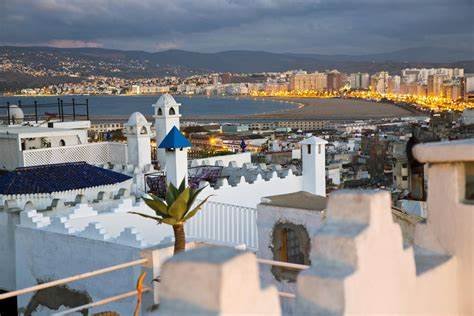
TANGIER TO CHEFCHAOUEN
Start your tour with the kasbah museum in the medina. The kasbah of Chefchaouen belongs to the early 18th century, and was built by the legendary ruler Moulay Ismail. It is fairly simple without architectural surprises however it is surrounded by gardens on the interior and exterior. Inside the Kasbah, you can visit the ethnographic museum containing antique weapons, musical instruments, and photographs of the old town.
– Step onto the museum’s roof and take pictures of a panoramic view of the Hispanic flavored town lined with blue and white washed houses, tiny balconies, tiled roofs and patios embellished with citrus trees. Next, visit the cobbled main square, Plaza Uta el- Hammam and where the striking 15th century Grand Mosque sits. The Mosque and its nearby buildings were built by Jewish refugees, who alongside Muslims escaped the Spanish persecution to Chefchaouen. Until the Spanish arrived in the 1920’s the town remained isolated and with the exception of three western men who snuck in.
– Chefchaouen’s blue and white washed buildings are reminiscent of the religious Jewish tradition that involves the weaving of Talis (Jewish prayer shawls) with Tekhelet, a blue dye prized by ancient Mediterranean civilizations and mentioned 49 times in the Hebrew Torah.
– After exploring the medina, have lunch at one of the local restaurants.

CHEFCHAOUEN TO FES
Today, visit the ancient Roman ruins of Volubilis sprawled over a wildflower dotted hillside. Excavated by the French in 1915, these Roman ruins date back to the 3rd century AD.
You will then visit the Celliers de Meknes winery and the Chateau Roslane to tour the cellars and sample the wines. Learn about the flavors and aromas, share the passion of the winemakers, choose to purchase (own expense) your favorites, and finish with a traditional Moroccan lunch
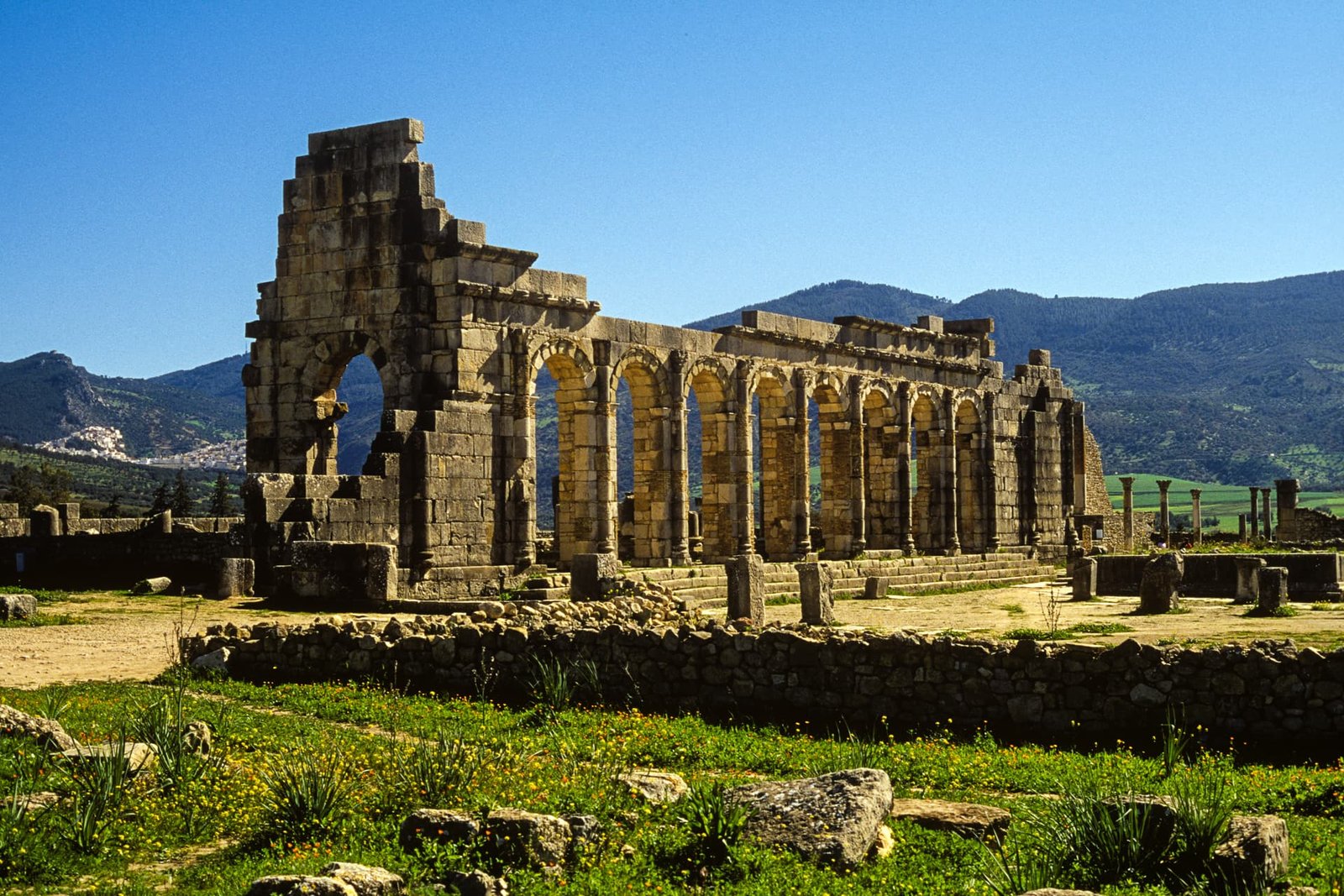
Volubilis
Meet your guide at the lobby of your hotel for a full day tour of Fez. Fes el Bali is a UNESCO World Heritage Site and was founded in the 9th century. Home to the oldest university in the world, Fez reached its height in the 13th-14th centuries under the Merinids, when it replaced Marrakech as the capital of the kingdom. The urban fabric and the principal monuments in the medina – madrasas, fondouks, palaces, residences, mosques and fountains – date from this period. Although the political capital of Morocco was transferred to Rabat in 1912, Fez has retained its status as the country’s cultural and spiritual center. Artisan workshops in the medina are as active today as 100 years ago, and strongly contribute to the city’s industrial economy. Trades such as metal and leather working, ceramics, silk, tapestries, and sculpting are still practiced in these workshops. Original ramparts still protect the ancient city and its’ 9000 passageways and narrow streets.
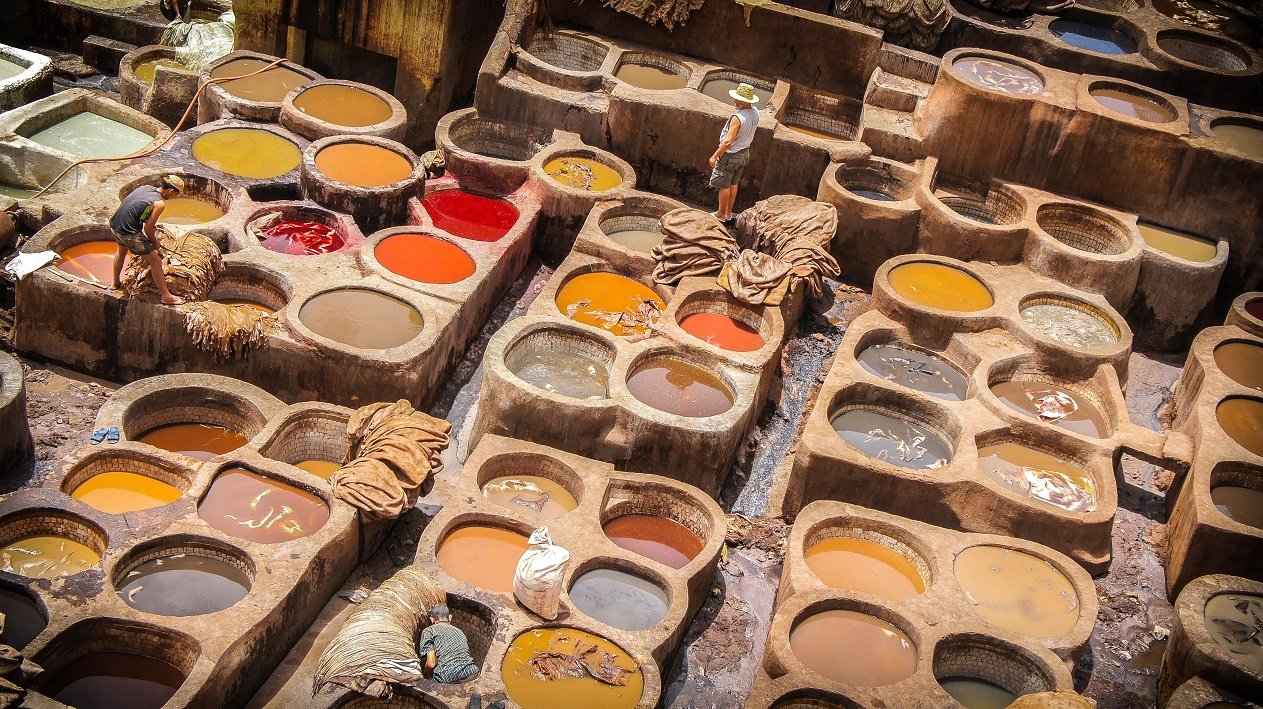
FES TO ERFOUD TO MERZOUGA
After breakfast, you will be driven to Erfoud, the gateway to the Sahara. here you will chnage to a 4X4 and continue to the dunes of Erg Chebbi which are a strikingly strange natural formation. On the top of the flattest area you could imagine, suddenly a long mountain of sand rises. This mountain is surrounded by flat and desolate nature on all sides, and you could end up wondering if it really is real. Enjoy a spectacular Camel Ride at sunset and dinner with overnight.
About the Desert Luxury Tented Camp Hotel: A sea of soft, warm, apricot-toned sands – the undulating landscape of the Erg Chebbi desert is one of Morocco’s most enchanting natural wonders. For millenia, travelers have marveled its infinite stillness – a beauty beyond words. For the weary traveler seeking such restorative magic, we offer a very special retreat: our Erg Chebbi Luxury Desert Camp. Our Luxury Camp offers the visitor an escape from the crowds of the cities – as well as contact with other tourist camps
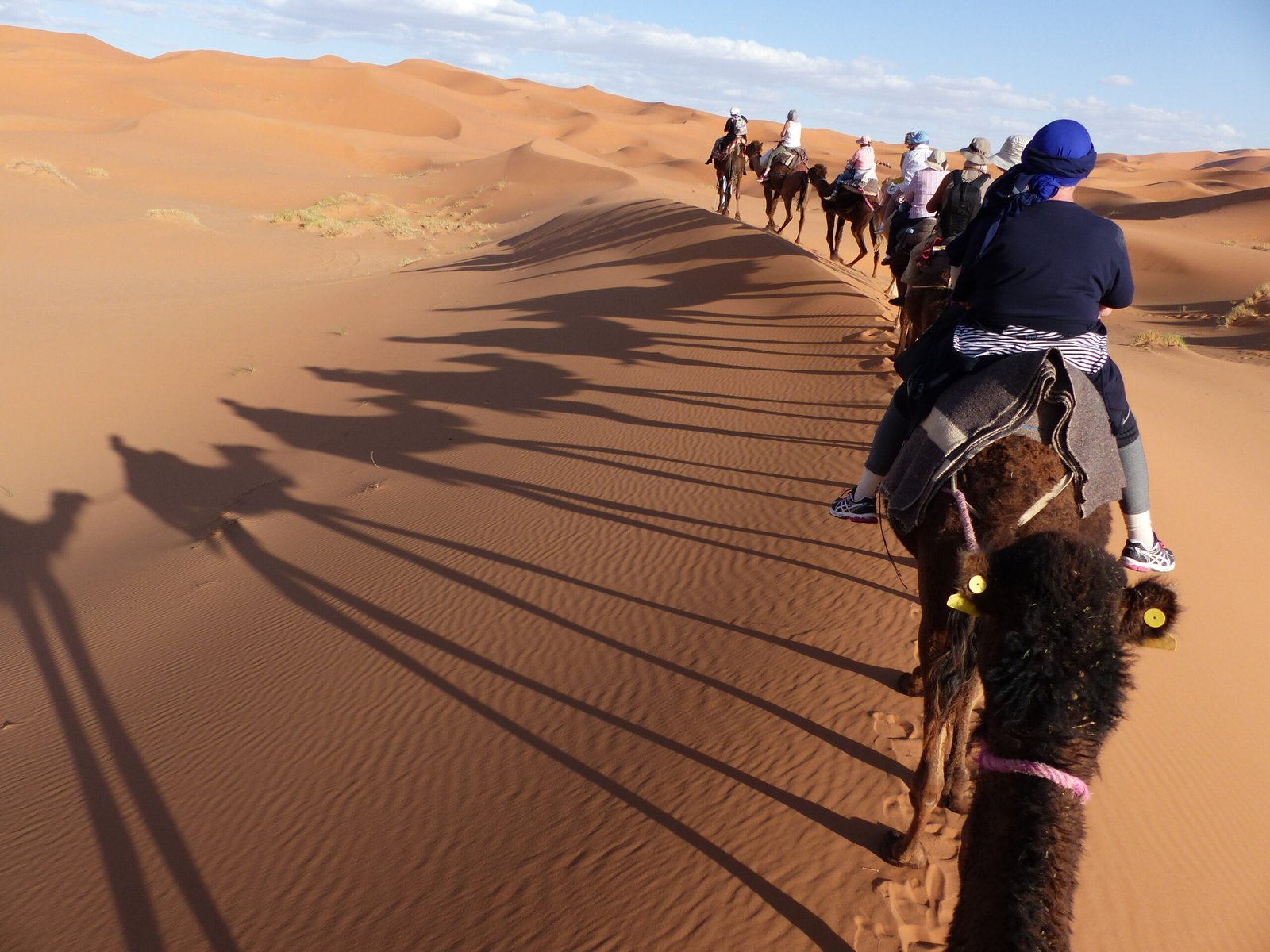
On the way
Early wake up to watch the sunrise over the dunes, return by camel to the foot of the dunes. After breakfast, Visit the small town of RISSANI, its large souk under its red arcades and its many ksour before arriving in Tinghir, You will take a beautiful road towards the Gorges du TODRA, the Kasbahs, the valley of roses , the SKOURA palm grove
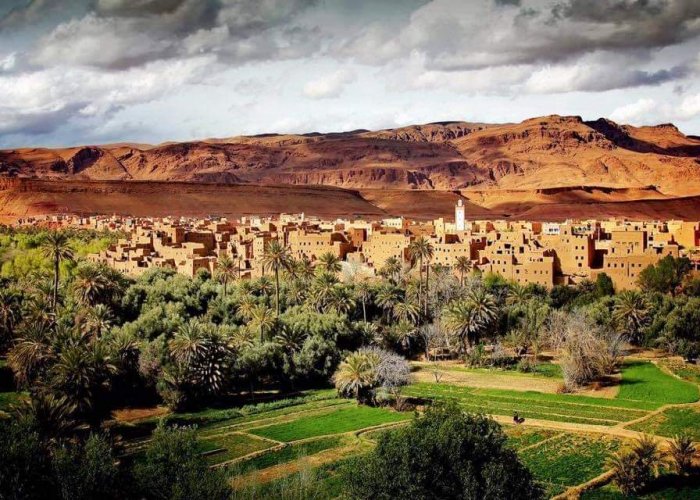
Exploring the Skoura Palm Groves and Lunch with a Berber Family
Today, visit Skoura and the Valley of One Thousand Kasbahs. Skoura is a fertile oasis lined with immense palm groves that provide great views of the Atlas Mountains alongside desert landscapes. It is renowned for the cultivation of roses. The palm groves were laid out in the 12th century by the Almohad sultan Yacoub el-Mansour and named after its original inhabitants, the Berbers of the Haskourene tribe. The most beautiful kasbahs in southern Morocco can be found here and many of them are still partially inhabited. The entrances to the palm groves in Skoura can be explored on foot.
The small, sleepy town of Skoura has a big market Souk every Monday. Explore all of this with your guide and then experience a traditional Moroccan Tagine lunch with a local Berber family.
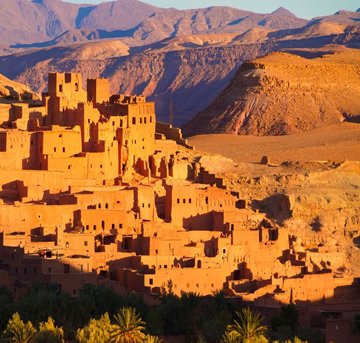
Onward and Upward
En route we stop at Ait Benhaddou. You will travel through the collar of Tizi Tichka, the highest passage of Morocco and all of North Africa, as you cross over the High Atlas Mountains. With the help of some Hollywood touch-ups, this UNESCO-protected red mudbrick ksar 32km from Ouarzazate seems frozen in time, still resembling its days in the 11th century as an Almoravid caravanserai. Movie buffs may recognize it from Lawrence of Arabia, Jesus of Nazareth (for which much of Aït Benhaddou was rebuilt), Jewel of the Nile (note the Egyptian towers) and Gladiator. A less retouched kasbah can be found 6km north along the tarmac from Aït Benhaddou: the Tamdaght kasbah, a crumbling Glaoui fortification topped by storks’ nests. You will then visit Tamdaght Kasbah and Telouet Kasbah.
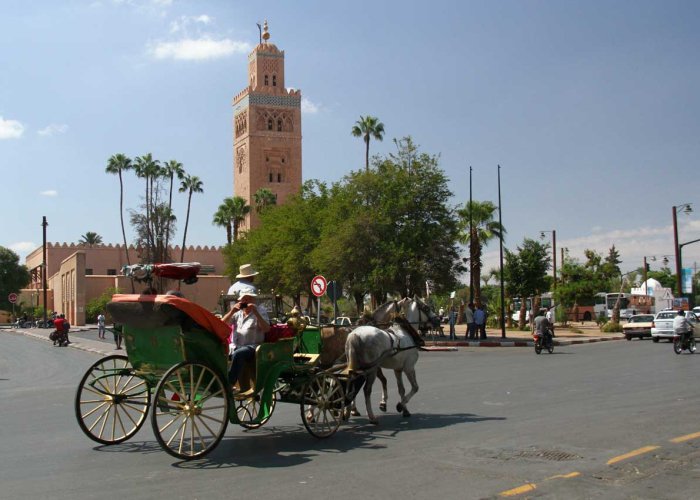
Get a Lay of the Land
Today, enjoy a full day of sightseeing of this incredible city. Your guide will meet you at the hotel lobby. Start with visits to:
Koutoubia Minaret
The center piece of Marrakech is the square tower of the Koutoubia minaret, attached to the Koutoubia Mosque, and built in the late 12th century. It’s not particularly high-about 250 feet-but it towers over the Medina thanks to a long-standing planning ordinance that forbids any other building in the old city to rise above it.
The Koranic School Medersa Ben Youssef
Theological college founded by the Merenid Sultan Abu Hassan in the 14th century, and restored in 1564 by the Saadians who made it the largest theological college in the Maghreb and a rival to the important Medersa Bou Inania in Fés.Then next Dar Si Saïd Museum in an Alaouite- style palace of the 19th century. See traditional crafts from southern Morocco, including carpets, costumes and weapons.
El-Bahia Palace
This 19th century palace is elaborate in its decoration and was built over a period seven years for Ba Ahmed, the son of the Grand Vizier Si Moussa. There are row after row of apartments-that once housed Ahmed’s harem-a trapezoidal garden, a huge tiled courtyard, and many hidden treasures, both in the form of antique objects d’art, and the palace’s convergence of Andalusian and Moorish architecture. Continue to Menara Gardens in the foothills of the Atlas Mountains, and wander among the olive trees surrounding the central lake.
Stop for a lunch at a local restaurant (You will pay directly for your meal).
After lunch you will continue the tour. You will have the visit of the botanical gardens of Marjorelle, a property acquired in 1922 by the painter of the same name and then bought and developed by Yves St Laurent. These gardens are an oasis in the heart of the city and rich with flora and fauna. Once inside the garden walls, you would never think you were in the heart of a busy city.
Then on to Le Jardin Secret. One of the largest and oldest riads in the medina has been beautifully restored to showcase the art and architecture of Moroccan gardens. Behind high walls is a hidden oasis that celebrates the ancient role of gardens and water in traditional Moroccan living. One garden features exotic plants from around the world; and the Islamic Garden symbolizes paradise as it is described in the Koran. In addition to the gardens and ancient water fountain system, there are restored buildings including a hammam and café that offers lovely views of the gardens and medina.
You will end the day by visiting the souks and the jamaa El Fna square
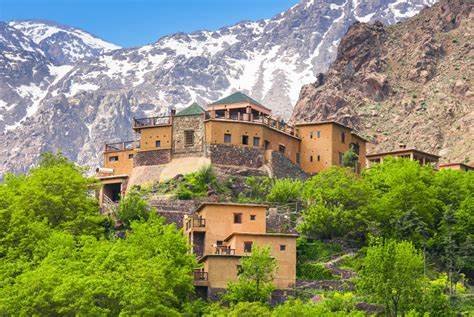
High Atlas Mountains
Depart Marrakech to the High Atlas, North Africa’s greatest mountain range, containing some of the most intriguing and beautiful regions of Morocco. A historical and physical barrier between the northern plains and the pre-Sahara, its Berber-populated valleys feel – and indeed are – very remote from the country’s mainstream or urban life. Mud-thatched Berber villages and remote pinnacles aren’t the only draw here. The landscape varies from season to season: winter drops meters of snow that leads to gushing river valleys in spring; summer brings an unforgiving sun, while the autumnal sunlight brings the browns and reds of the peaks to life.
The 5* hotel Kasbah Tamadot is situated in the breathtaking Atlas Mountains in Morocco. The magical retreat Kasbah Tamadot is owned by Sir Richard Branson. The hotel is located at the top of a valley with views up to Mount Toubkal and over to some of the traditional Berber villages of Asni.
Once you arrive there you will have a short walking with a local guide around the Berber villages then you break for lunch. At the end of the afternoon you will return to Marrakech.
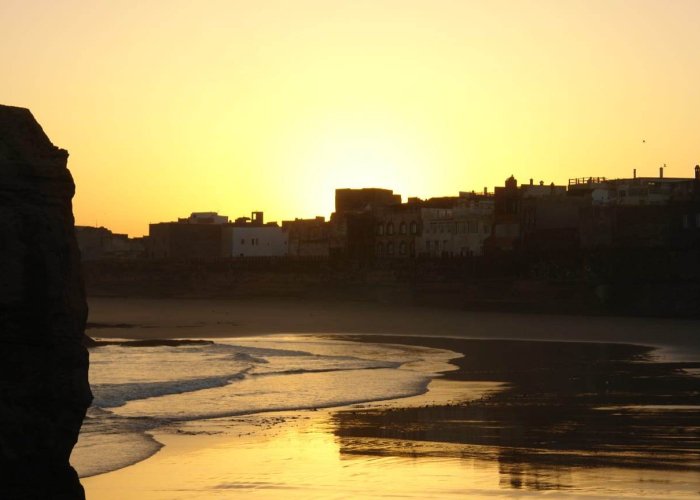
JEWISH HERITAGE SITES
-En route to Essaouira stop at an Argan Cooperative to see how women make Argan Oil, Nut Butter and cometics from the Argan nut. Option to continue directly to Essaouira or visit a local winery for a wine and cheese tasting. Enjoy the local wines produced in the region of Essaouira.
-Take a stroll along the town’s sunlit pedestrian main square, Place Prince Moulay el Hassan and the Skala du Port, the fishing harbor, offers breathtaking views of the Portuguese ramparts. Explore the ramparts and the spice and jewelry souks of the medina.
-The medina of Essaouira (formerly “Mogador”) is a UNESCO World Heritage listed city, as an example of a late-18th century fortified town.
-Have lunch at the fish-grill cafes, with wooden tables and benches laid out overlooking the sea that was once- in the 19th century- the only Moroccan port south of Tangier. After lunch visit Orson Welles’ Square and memorial, designed by Samir Mustapha, one of the towns artists, which pays homage to Orson Welles filming of Othello in Essouaria. Essaouira’s history is a reminder of the times when Spain, Portugal and England fought to maintain control over its coasts. It has a typical Portuguese harbor that is a stunning example of Moorish and Portuguese architecture.
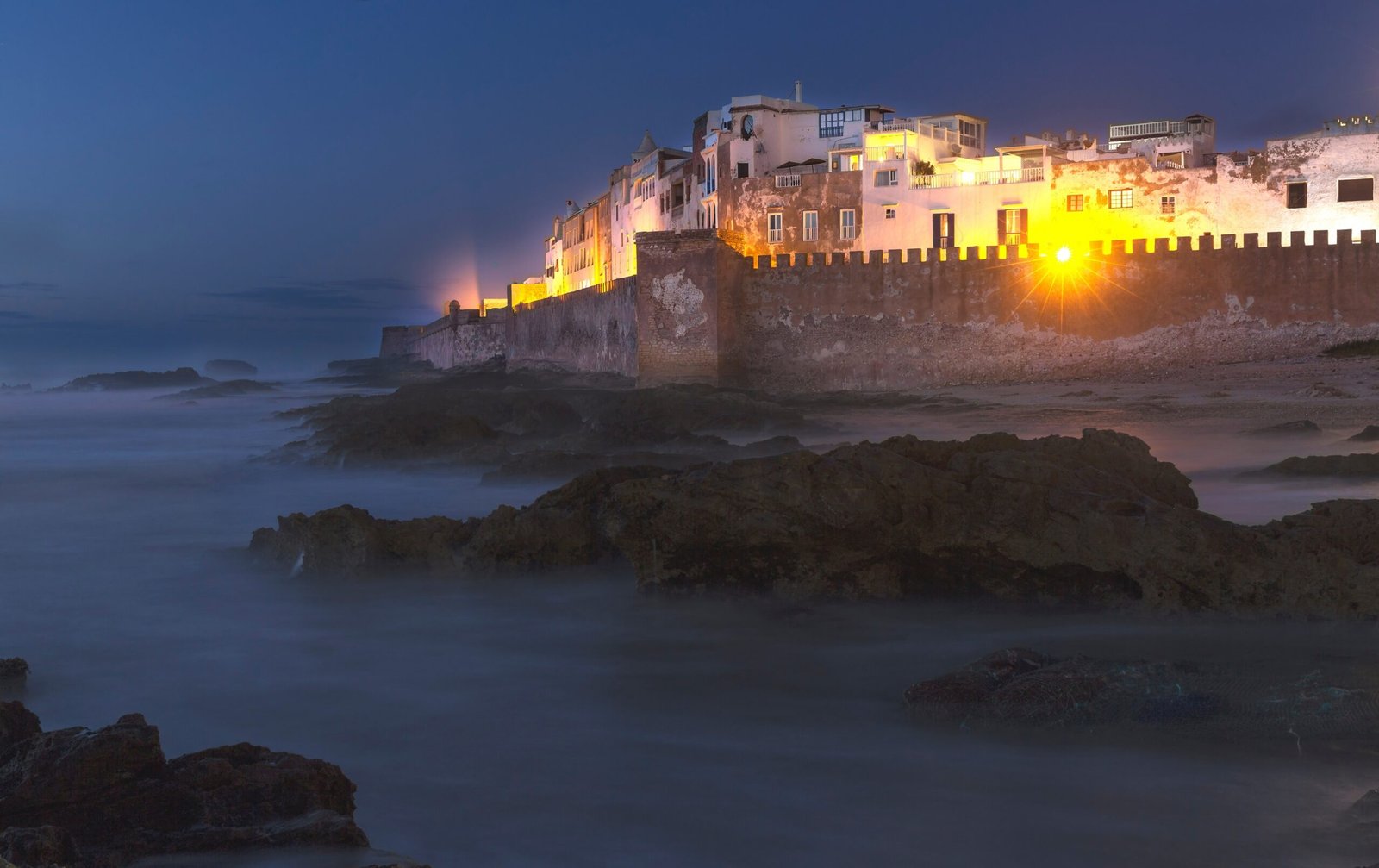
The medina of Essaouira
-Site see in Orson Welles Square and the Portugese Ramparts
-Visit Thuya Workshop, Art Galleries and enjoy a traditional Moroccan lunch or local catch at one of the fish-grill cafes
-Discover UNESCO World Hertiage and the Soulful door paintings and carved emblems in the historic medina
-Optional: Visit Jewish Heritage Sites: Synagogues, Cemeteries & Stories of the Jewish Mellah
-Visit this sea-side medieval town that boasts lovely white-washed and blue-shuttered houses, colonnades, thuya wood workshops, art galleries and mouthwatering seafood. Once called Mogador by European sailors and traders, Essaouria is known for its annual GnaouaMusicFestival that attracts 300,000+ people in June. It also has an expansive beach for surfing called Plage de Safi.
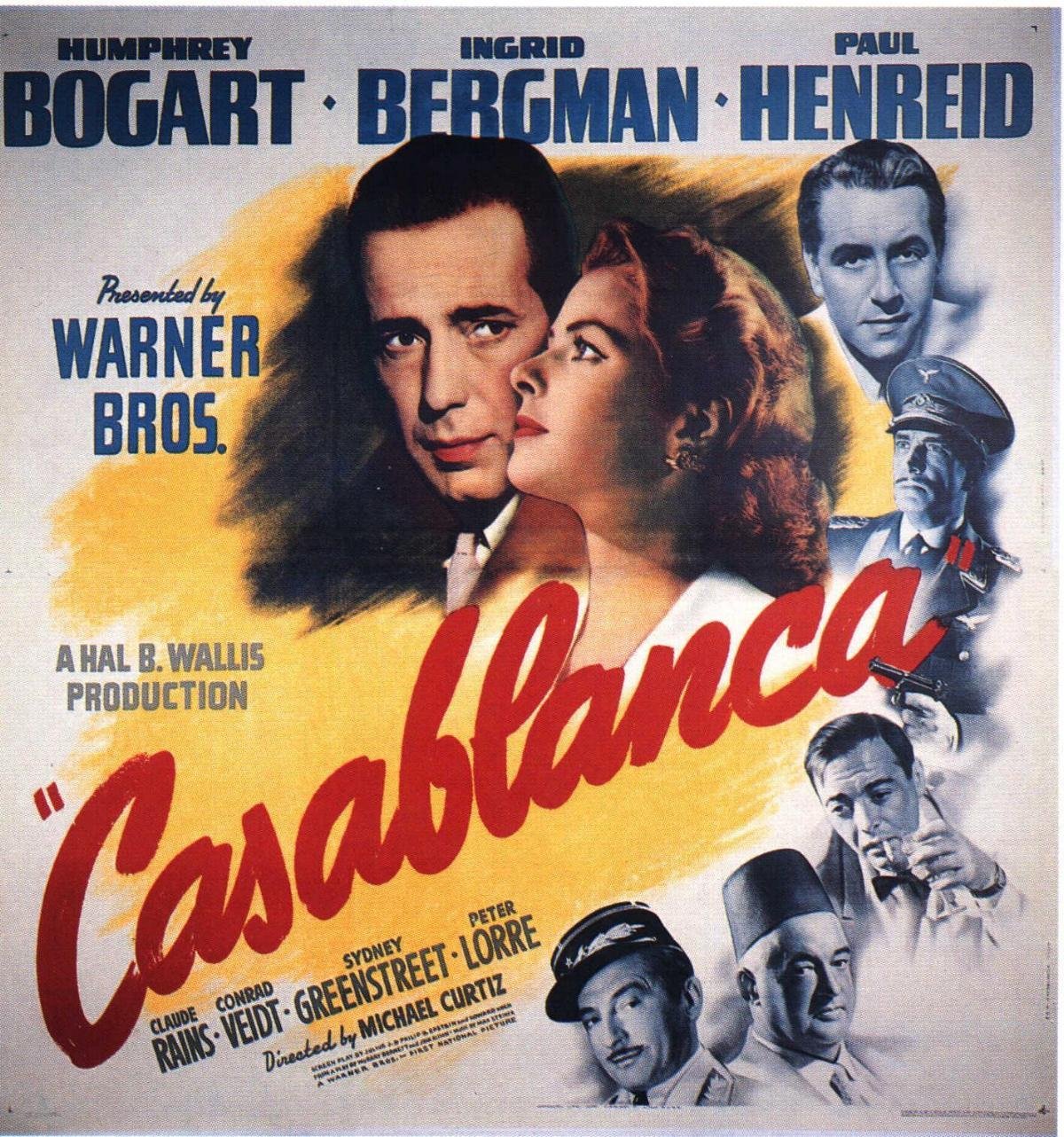
Discover Art Deco Casablanca.
Make sure you have a camera in hand to take pictures of the famous clock tower, art deco hotels, the eleven story Moretti apartment block and the high rise art deco buildings covered with loggias, columns, zellij tiles and geometric carvings on Boulevard Mohammed V with Art Deco facades. (If time allows)

Departure from Morocco
Transfer to the Casablanca airport for your departure flight
Not Included:
– Flight tickets & visa
– Entrance tickets to monuments and museums
– Personal expenses
– Tips to guide and driver (optional)
– Anything not stated in included part
– Roundtrip flights to Marrakech
– Painting equipment
– On-site purchases.
– Cocktails / henna party
-Traditional hamam
– Entrance fees to monuments
Good To Know
Travelers from the US only are required to have a valid US Passport – but it must NOT be due to expire within 6 months of your return flight.
Your flight destination will be to Casablanca Mohammed V International Airport. Royal Air Maroc is the only airline that has direct flights from the US to Morocco, from both JFK and Washington Dulles.
Immunizations are not required or necessary but check here for CDC recommendations.
What To Wear
Weather is predictably unpredictable so be sure to check on the estimated conditions the week before you travel. Even though Marrakech can be quite warm by day, it is usually quite cooler at night so pack light clothes that you can layer. We recommend cotton pants, long skirts, wraps or large scarves over tank and tee shirts, and a sweater or light jacket for chilly nights.
Your most important fashion asset: comfortable shoes for traversing the Medina on sightseeing and shopping adventures!
Morocco is a Muslim country and women generally dress more modestly than in the US or Europe. Like elsewhere, dress codes are gradually becoming more lax and there is a lot of tolerance for tourists, but wearing clothing that covers your best “assets”, and that your grandmother would approve of, shows cultural respect, good taste, and common sense.
Money Exchange
The currency here is the Moroccan Dirham, and the exchange rate usually hovers these days around 10 Dirhams/1 Dollar. You CANNOT exchange for Dirhams outside of Morocco, but there are several currency exchange booths in the airport when you exit Passport Control and also located all around the Medina. Larger stores and restaurants may take Euros, but it’s really best to have dirhams.
If you bring large bills ($100) to exchange be sure that they are newer bills with holograms. Otherwise they will slide them back to you with a shake of their head.
Another good option for padding your wallet with dirhams is to use the ATM machines which are located around the medina. The exchange rate is a little better, especially if your bank or credit card doesn’t add foreign transaction fees (some homework for you). Be sure to notify your bank of your foreign travel destination so they don’t flag you for fraud. I also recommend that you bring 2 or 3 cards-just in case you still get flagged (happens!) and find too many things you just can’t live without.
Guest House
Free Wifi access in all rooms and common areas
Bedside Mineral Water
Hair Dryers
One-time complimentary laundry service for retreat weeks
Extra items you should pack:
European Plug adapters
Electricity Converter for hair appliances (cellphones and computers generally have built-in converters)
Traditional Dishes
One of the most notable aspects of Moroccan cuisine is the emphasis on the quality and freshness of ingredients. The produce is sourced from a land free of pesticides, chemicals, hormones, or preservatives. Animals are typically slaughtered just hours before they are used, with mutton being the prevalent meat offered, rather than lamb. Market vegetables are freshly gathered each morning. The use of spices, herbs, fresh fruits, nuts, and dried fruits imparts an invigorating vitality that stands in stark contrast to the packaged and imported products commonly found in much of Europe and North America.
To further acquaint you with the culinary delights, here are explanations of some of the most common and popular traditional Moroccan dishes:
Harira: A thick soup made of chickpeas, lentils, and haricot beans, often flavored with mutton or chicken, lemon, and tarragon.
Brochettes: Grilled kebabs featuring mutton, liver, and fat.
Kefta: Spicy meatballs crafted from minced mutton and offal, often served in a seasoned sauce.
Pastilla/Bastilla: A pie composed of multiple layers of flaky pastry filled with chopped pigeon meat, eggs, almonds, and spices. Chicken or fish may be used as alternatives to pigeon.
Tagine: Alongside couscous, this is one of the most ubiquitous Moroccan dishes—a slowly simmered stew cooked in its own juices in an earthenware bowl with a distinctive conical lid. Variants include tagine de viande (mutton stew with vegetables or served alone with prunes), tagine de poisson (bream or sardine stew with tomatoes and herbs), tagine de lapin (rabbit stew), and tagine de poulet aux olives et citron (a delicious chicken stew with lemon and olives). The lemon imparts a delightful bitter zest to the meat.
Mechoui: Lamb roasted whole on a spit or baked in a special oven. This delicately fragrant meat, distinct from typical mutton, is often enjoyed with bread but is considered an elaborate luxury that may need to be ordered well in advance.
Couscous: Made from half-baked flour ground into semolina-like grains, perfectly prepared couscous involves a meticulous cooking process with steamings and oilings, resulting in distinct granular texture. While best enjoyed in a home or a quality restaurant, it is often served with sept légumes (seven steamed vegetables) and occasional mutton. Couscous can also be served as a dessert with sugar, cinnamon, and rich, warm goat's milk.
Cornes de Gazelle: Croissant-like pastries filled with honey and almonds.
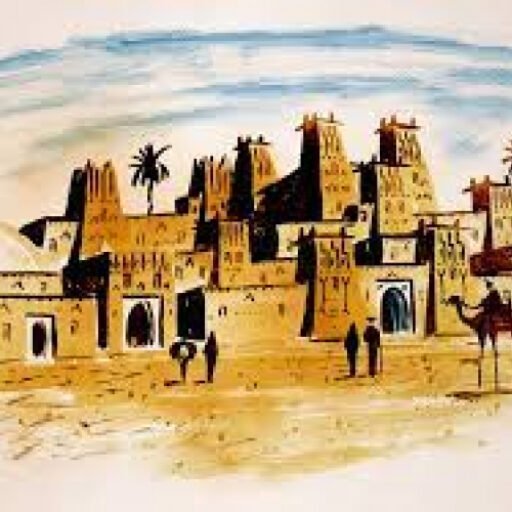
Don't miss this adventure of a lifetime! Explore the Sahara Desert Atlas Mountains, and iconic cities like Fes, Marrakech, Chefchaouen, Casablanca
An 15-day journey through Morocco offers a tapestry of experiences, from the architectural marvels of Casablanca to the serene blues of Chefchaouen. Begin your adventure in the bustling heart of Casablanca, where tradition and modernity blend seamlessly. As you travel to the picturesque Chefchaouen, the Rif Mountains provide a stunning backdrop to the city's tranquil, blue-washed buildings. The ancient city of Fes awaits next, inviting you to lose yourself in its labyrinthine medinas and rich history. The Moroccan desert then unfolds its vast expanse, offering moments of reflection and adventure, such as a camel trek at sunset or a night under the stars in a Berber camp. The journey continues through the dramatic landscapes of the Dades Gorges before culminating in the vibrant streets of Marrakech, where the senses are enlivened by the bustling souks and the lively Jemaa el-Fnaa square. This itinerary promises not just a voyage through Morocco's diverse landscapes but an immersive journey into the very soul of its culture.
- Casablanca, Rabat, Tangier, Chefchaouen, Fes, Erfoud, Merzouga, Ouarzazate, Marrakech, Essaouira

Jour 1 : Prise en charge à l’aéroport Ibn Batouta de Tanger, vers 14h. Bus pour Asilah (50 km, environ 1h). Nuit à Assilah.

Jour 2 : Visite du port de pêche d’Asilah, qui se situe juste à côté de la médina. Il est possible de voir des petits bateaux traditionnels qui servent encore à la pêche. Nous visiterons et dessinerons les murs que les Portugais ont construits au XVe siècle. Se promener autour du port de pêche est très agréable, notamment en fin de journée pour admirer le coucher de soleil sur l’océan. Nuit à Assilah.

Jour 3 : Journée à Tanger. Tour de ville panoramique le long de La Corniche et du Bvd. Pasteur, dans la ville moderne. Visite du souk et de la Médina où nous visiterons le Musée de la Kasbah. Repas. Après-midi au Café Hafa et bus pour Asilah (50 km, environ 1 heure). Nuit à Assilah.

Jour 4 : Départ pour Tétouan (100km, environ 1’45 heures). Arrêtez-vous pour visiter cette ancienne colonie espagnole et dessinez sa vieille ville. Départ pour Chaouen (70 km, une heure et demie). Arrivée à notre Riad particulièrement bien situé dans la Médina. Nuit à Chaouen.

Jour 5 : Petit-déjeuner et première sortie dans les ruelles colorées de la ville : première installation dans les ruelles
pour peindre et dessiner ces adorables portes bleues, pique-nique ou repas léger. Après-midi : Autre endroit pour découvrir et peindre les belles fontaines colorées. Nuit à Chaouen.

Jour 6 : Dessin panoramique de la « ville bleue » depuis une colline voisine. Nous visiterons les terrasses fluviales. Et l’après-midi nous continuerons à dessiner les ruelles de Chaouen. Nuit à Chaouen.

Jour 7 : Matinée à la maison rurale pour compléter le cahier, avec conseils de conception, partage de cahiers, etc. Déjeuner. Dans l’après-midi, nous partirons pour Tanger. Nuit à Assilah.

Jour 8 : Après le petit-déjeuner dans notre Riad, transfert à l’aéroport aura lieu.
